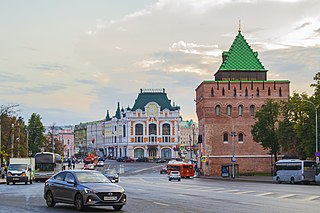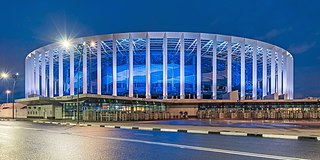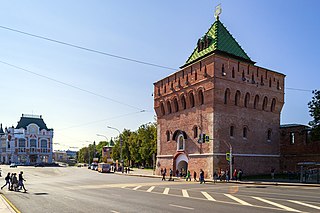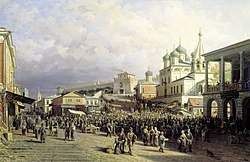
Nizhny Novgorod, colloquially shortened to Nizhny, from the 13th to the 17th century Novgorod of the Lower Land, known from 1932 to 1990 as Gorky, is the administrative centre of Nizhny Novgorod Oblast and the Volga Federal District in Russia. The city is located at the confluence of the Oka and the Volga rivers in Central Russia, with a population of over 1.2 million residents, up to roughly 1.7 million residents in the urban agglomeration. Nizhny Novgorod is the sixth-largest city in Russia, the second-most populous city on the Volga, as well as the Volga Federal District. It is an important economic, transportation, scientific, educational and cultural center in Russia and the vast Volga-Vyatka economic region, and is the main center of river tourism in Russia. In the historic part of the city there are many universities, theaters, museums and churches.

Tourism in Russia plummeted in 2022. Only 200,100 foreigners visited Russia in 2022, a drop of 96.1% from pre-pandemic/pre-2022 Russian invasion of Ukraine years. Earlier, Russia had seen rapid growth since the late Soviet times, first domestic tourism and then international tourism as well. Russia had formerly been among the most popular tourist destinations in the world, though it fell off that list in 2022. Not including Crimea, the country contains 23 UNESCO World Heritage Sites, while more are on UNESCO's tentative lists.

Nizhny Novgorod Oblast is a federal subject of Russia. Its administrative center is the city of Nizhny Novgorod. It has a population of 3,119,115 as of the 2021 Census. From 1932 to 1990 it was known as Gorky Oblast.

Gorodets is a town and the administrative center of Gorodetsky District in Nizhny Novgorod Oblast, Russia, located on the left bank of the Volga River, 53 kilometers (33 mi) northwest of Nizhny Novgorod, the administrative center of the oblast. Population: 30,658 (2010 Census); 32,442 (2002 Census); 34,210 (1989 Census); 34,000 (1970).

Kstovo is a town and the administrative center of Kstovsky District in Nizhny Novgorod Oblast, Russia, located on the right bank of the Volga River, 22 kilometers (14 mi) southeast of Nizhny Novgorod, the administrative center of the oblast. Population: 66,657 (2010 Census); 66,944 (2002 Census); 62,414 (1989 Census).

Arzamas is a city in Nizhny Novgorod Oblast, Russia, located on the Tyosha River, 410 kilometers (250 mi) east of Moscow. Population: 106,362 (2010 Census); 109,432 (2002 Census); 108,951 (1989 Census).

Nizhny Novgorod Fair was a fair in Nizhny Novgorod held annually every July near Makaryev Monastery on the left bank of the Volga River from the mid-16th century to 1816. Following a massive fire in 1816, it was moved to Nizhny Novgorod, but for some decades thereafter it still was commonly referred to as Makaryev Fair. It attracted foreign merchants from India, Iran, and Central Asia.

The Nizhny Novgorod Metro, formerly known as the Gorky Metro, is a rapid-transit system which serves the city of Nizhny Novgorod, Russia. Opened in 1985, it consists of 15 stations and is 21.6 kilometres (13.4 mi) long. The metro connects with the City Rail and Nizhny Novgorod Central Diameters systems at the Moskovskaya station. It has the third-largest number of stations of any Russian subway system, the largest two being Moscow and St. Petersburg.

Lyskovsky District is an administrative district (raion), one of the forty in Nizhny Novgorod Oblast, Russia. Municipally, it is incorporated as Lyskovsky Municipal District. It is located in the east of the oblast on both sides of the Volga River. The area of the district is 2,134 square kilometers (824 sq mi). Its administrative center is the town of Lyskovo. Population: 39,964 ; 43,755 (2002 Census); 46,895 (1989 Census). The population of Lyskovo accounts for 54.7% of the district's total population.

Nizhny Novgorod Stadium is a football stadium in Nizhny Novgorod, Russia. It was one of the venues for the 2018 FIFA World Cup. It has a capacity of 44,899 spectators.

The Nizhny Novgorod Kremlin is a fortress (kremlin) in the historic city center of Nizhny Novgorod, Russia.

Moskovskaya is a station on both Line 1 and Line 2 line of the Nizhny Novgorod Metro. It was one of the first six stations to open on the line on 20 November 1985. It is also the only station that permits transfers from one line to the other. Passengers may also transfer to the main Nizhny Novgorod railway station. Also, the metro station Moskovskaya is a transfer hub to the station of the City Rail Nizhny Novgorod-Moskovsky.

Nizhny Novgorod railway station is a central station in Nizhny Novgorod, Russia. In terms of the amount of work performed, the 1st class station, and by the nature of the work performed, is a cargo station. It was opened on August 2, 1862.
The following is a timeline of the history of the city of Nizhny Novgorod, Russia.

The Alexander Nevsky Cathedral is a Russian Orthodox cathedral church located in the Kanavinsky city district of Nizhny Novgorod. The cathedral is located on the former territory of the Nizhny Novgorod Fair. It is one of the unofficial symbols of Nizhny Novgorod, along with the Dmitrovskaya Tower of the Kremlin, the Chkalov staircase and the fair.

Rozhdestvenskaya Street – an historic street in Nizhny Novgorod. Is a unique open-air museum, there are only stone houses, the history of the oldest of which dates back to the middle of the 18th century. Officially there are 35 monuments of architecture. The most famous landmark is the Church of the Nativity.

The Minin and Pozharsky Square, also known as just Minin Square, is the main square of Nizhny Novgorod. It is a social and cultural center of the city, the venue of the most important celebrations. It is located in the historical centre of the old town from the southeast side of the Kremlin.

Nizhny Novgorod was founded by Prince Yuri II of Vladimir in 4 February 1221. Citizens organized an army to liberate Moscow from the Poles in 1611, led by Kuzma Minin and Prince Dmitry Pozharsky. During the Russian Empire, in 1817 Nizhny Novgorod became the country's main trading city. In 1896, the city hosted the largest All-Russia exhibition. In the Soviet era, Nizhny Novgorod was renamed Gorky, in honor of the writer Maxim Gorky. Then it was the industrial center of the Soviet Union. During the World War II, the city sent to the front a huge amount of military equipment and ammunition. Therefore, the German air force bombed the city for 3 years. After the dissolution of the Soviet Union, the city was renamed back to Nizhny Novgorod. In Russia, the city became a political center and the capital of the Volga Federal District. Now the city is the center of information technology and develops tourism.

The Spit of Nizhny Novgorod is one of the main natural landmarks in the historical centre of Nizhny Novgorod. It is located at the confluence of the Oka and Volga rivers.

Elizaveta Solonchenko is a Russian politician who served as the Head of Nizhny Novgorod (2017), Deputy Head of Nizhny Novgorod (2013–2017), Deputy Chairman of the City Duma of Nizhny Novgorod. She has been critical of the federal government.



























